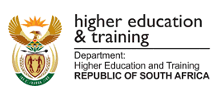Research on institutional responsiveness and student employability in the vocational education and training curriculum has now been completed. Seven case studies were conducted across different types of PSET institutions, in the agribusiness (sugar and forestry) and automotive production and maintenance sectors. The research investigated five broad drivers that shape the kinds of curriculum responses that can enable or hinder employability:
-
In terms of employers, the key finding was that there is no single view on what makes people employable, and what employers’ training responsibility should be. Most critically, in assessing qualifications, employers placed great value on reputation and trust, signalling a need to raise awareness and build understanding about new qualifications. General concern was raised about poor levels of general education, and this was directly related to the ‘soft’ skills often associated with employability. The case studies revealed a number of very positive partnerships between employers and education providers and there was a general willingness to engage. There was also a question about how closely programmes should be aligned to a specific industry, as this may in fact limit employability and ultimately make a programme unattractive.
-
The extent to which student needs were taken into account varied across the cases. Structured programmes of support or simply caring lecturers made a difference. For most students the greatest obstacles were material issues such as accommodation, transport and food. Addressing the obstacles requires a multi-pronged approach.
-
Policy (or lack thereof) framed the curriculum and in some instances constrained what could be achieved. For example, the requirements of the NQF made it difficult to combine different levels of knowledge and purpose in one work oriented programme. Requirements for work integrated learning (in the form of work-placement) created blockages in the system that were beyond the control of education providers. Policy and regulations also facilitated coordination within a sector or industry that made it easier to respond to skills needs at this meso-level.
-
There are also social and environmental pressures and concerns that demand a response, based on an ethical and social justice imperative. These responses may at times act in tension with employer perspectives, but do offer a vehicle through which wider generic skills can be taught.
-
Curriculum is always mediated by the capacities and resources available in the organisation, and has to align with organizational procedures. Curriculum decisions are shaped by staffing needs, organizational systems and priorities and strategic decisions such as cross-programme outcomes.
Overall, the research findings suggest that curriculum responsiveness is a complex interplay of multiple factors and not a simple correspondence between employer needs and curriculum. It is not helpful to view curriculum narrowly in terms of what is part of a single qualification. Rather, we should understand it as a course of learning with a specific end goal, for example competent practice in an occupational field. In order to achieve this, the formal learning in a qualification is one component of, but not the entire, pathway. Critically, there needs to be recognition of what learning is assumed to be in place before, and what learning will happen once, the student enters the workplace (and measures to redress gaps). This is partially addressed through work-placement, but also through mentorship and induction, which employers should structure much more systematically as part of the curriculum.
The question as to whether programmes should be focused on specific industries or should focus on occupations more broadly emerged in a number of cases. Training at a broader level increases employability because workers are able to move from one industry to another. However, some occupations are industry specific so this cannot always be applied, without sacrificing the core knowledge underpinning the occupation. Here, what emerges as critical is the degree to which specific industries or firms accept that they need to have training programmes in place that allow students to make the transition from the general occupational level to the specificities of the job in context.
A recurring theme across the cases was the issue of trust, between parties and in specific institutions or programmes. This is based on partnerships in many cases, where relationships are developed. These provide a number of models for engagement. Partnerships are not easily sustainable without commitment and resources (particularly time) and this is something that needs to be supported. There are also examples of lack of trust in the unknown, which results in programmes not leading to employment. In these cases the curriculum itself is not at issue, but rather perceptions about the institution or programme may be.
Finally, the cases highlighted the need to view the interplay between different components of a skills ecosystem. There is an interplay between higher levels of skills and intermediate skills, the formal and informal economy, locality and local level policy. Skills planning thus needs to look at the dynamics within a specific region in order to understand what skills are needed locally, what can be attracted from elsewhere and how these mechanisms work. Having a good skills set in the wrong place has a direct bearing on employability.
The full research report on which this briefing note is based:
Sybert Mutereko and Volker Wedekind. 2015. A synthesis report on curriculum responsiveness and employability.





